This year marks the fifth annual EDUCAUSE Current Issues Survey to identify what campus information technology leaders see as their most critical IT challenges.1 Thirty-five percent (571) of the 1,638 EDUCAUSE primary member representatives who were asked to participate responded to an e-mail invitation to complete the Web-based survey in December 2003. Survey participants were asked to check up to five of 30 issues in response to each of four questions (see Tables 1 and 2).
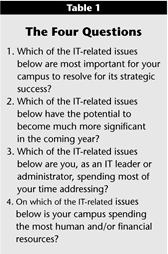
Click image for larger view.
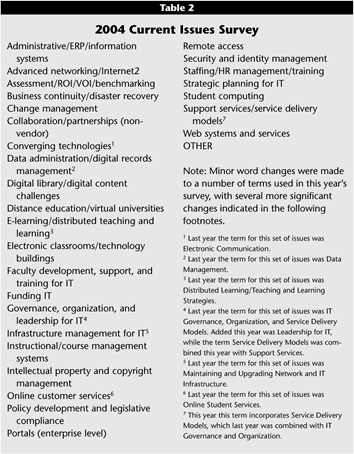
Click image for larger view.
Survey Findings: All Respondents
Three overall findings for all respondents to this year’s survey are especially notable.
First, for the second year in a row, Funding IT remains the number-one IT-related issue in terms of its strategic importance to the institution (Question 1), its potential to become even more significant (Question 2), and its consumption of IT leaders’ time (Question 3). And in 2004, it appears for the first time on the list of greatest expenditures of institutional resources (Question 4), most likely indicating that more human resources are being spent on this issue. Three years of economic downturn—which has reduced private giving and significantly reduced state budgets—has resulted in substantially lowered institutional budgets and IT budgets in particular. While there has been an upturn in the U.S. economy recently, improvements in IT budgets are not likely to be seen for several years. In such an environment, the challenge is not so much lobbying to increase IT budgets overall as distributing flat or shrinking resources creatively, managing more complex infrastructures efficiently, and prioritizing among rising appetites for bandwidth and academic and administrative functionality.
The second notable finding is that not only does Security and Identity Management remain among the top-ten issues on all four measures (strategic importance, growing in significance, demanding the campus IT leader’s time, and expenditure of human and fiscal resources) but has risen dramatically in the last (resource consumption) category—from eighth in 2003 to third in 2004. This jump suggests that campus plans for improving IT security in the wake of the terrorist attacks of September 11, 2001, have moved into implementations and staffing changes that are having a significant impact on budgets. Another likely factor is the number of viruses and denial of service attacks that make networks vulnerable to costly down time.
Finally, two new issues have made the top-ten list for Question 1 in 2004: Business Continuity/Disaster Recovery and Governance, Organization, and IT Leadership. Beyond a logical tie-in with security concerns for the first of these, the appearance of these issues suggests a growing realization of the strategic importance of IT and the close relationship of leadership and governance for this critical resource.
Comparing responses across all questions for all respondents, four issues rank in the top ten in all four areas.
- Administrative/ERP/Information Systems
- Funding IT
- Infrastructure Management
- Security and Identity Management
Three other issues are on the top-ten lists for three of the four questions.
- Strategic Planning for IT (all but Question 4, resource consumption)
- Support Services/Service Delivery Models (all but Question 1, strategic importance)
- Web Systems and Services (all but Question 3, IT leaders’ time)
How do these results compare to last year’s? Table 3 presents the top-ten issues for all respondents for each of the four questions for 2003 and 2004. There are several changes worth noting in this comparison.
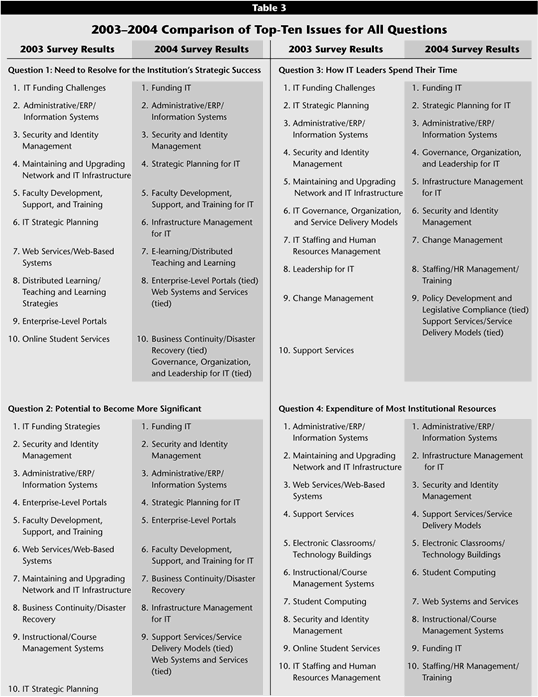
Click image for larger view.
Strategic Planning for IT, which continues to be the second most time-consuming issue for IT leaders, has risen from tenth to fourth among those challenges with the potential to become more significant and from sixth to fourth among those critical for the institution’s strategic success. This is likely the result of having to better align IT activities with the institution’s priorities—always a recognized need but in hard times a priority. There may also be the coat-tail effect of the IT funding crisis; that is, with IT funding continuing to be a critical concern, strategic planning is becoming even more important because of the recognition of the need to align planning and budgeting for IT.
Perhaps related to the increase in importance of Strategic Planning, the issue of Governance, Organization, and Leadership for IT has risen in IT leaders’ time commitment and now appears for the first time among issues critical for institutional success. As budgets tighten and new models of service delivery and staff deployment must evolve, it is not surprising to see such a shift.
Web Systems and Services continues to appear among the top-ten IT issues in three of the four measures but has slipped in all three. It may be that it is becoming subsumed, for some institutions, under the perennially important issue of Administrative/ERP/Information Systems. New ERP systems are being designed to support a self-service information-delivery model and, thus, inherently overlap with Web platform issues. For the survey, the issue of Web Systems and Services was defined as including Web-based business strategies, integrating legacy and Web-based systems, managing content development and currency, stewardship policy, content management, enterprise portal strategy, and Web standards and architecture.
Other key findings include the following:
- Instructional/Course Management Systems has dropped off the list of issues expected to become more significant and has slipped from sixth to eighth on the list of top-ten campus IT expenditures. While instructional technology certainly continues as a significant consumer of resources, we might infer that CMS as an issue per se has spiked and is now folding into the suite of regularly supported technologies.
- Support Services/Service Delivery Models is new this year on the list of issues expected to increase in significance overall. With multiple years’ worth of budget cuts, the support crunch is back. This was a top-ten issue a few years ago when the phrase "support crisis" was in vogue, for good reason.
- The top three issues on last year’s list of those expected to become more significant—Funding IT, Administrative/ERP/Information Systems, and Security and Identity Management—were indeed the top three on this year’s strategic issues list.
- One issue not identified as emerging in significance last year suddenly appeared on the strategic issues list this year: Governance, Organization, and Leadership for IT.
As in past years, the survey results show some differences between what issues IT leaders are spending most of their time on and the top issues for the other three questions. For the most part, the CIOs and senior IT administrators who respond to these questions are responsible for all elements of the IT organization, its current services to many campus constituencies, multi-year planning, resource management, and intersection with broad institutional goals. Thus, we would expect to have them report spending time on some things that do not typically appear in the other lists. In 2004, these are
- Change Management
- Governance, Organization, and Leadership for IT (though this did make the strategic issues list for the first time this year)
- Policy Development and Legislative Compliance (new to the IT leaders’ top-ten list this year), not surprisingly because of myriad legislative and campus policy issues related to IT, such as the USA PATRIOT Act, SEVIS, HIPAA, and others.
In 2004, there have been two dramatic changes in IT expenditures. As mentioned above, Security and Identity Management moved from eighth place in 2003 to third in 2004, no doubt reflecting increased national awareness of security risks, institutional and state mandates to better secure IT infrastructures, and emerging effective IT security practices.2 The other notable change in IT expenditures is that Web Systems and Services has dropped from third last year to seventh this year. This might mean that major start-up costs in this area are now behind many institutions, or, as suggested above, it is understood as subsumed under the Administrative/ERP/Information Systems issue, which continues for the fifth straight year as the most resource-intensive area. Issues that appear on the expenditures list that do not appear among strategic or emerging issues include Electronic Classrooms/Technology Buildings, Student Computing, and Staffing/HR Management/Training—typical ongoing expenditures that tend not to be viewed as strategic.
Demographic Similarities and Differences
The Current Issues survey measures differences by control (public versus private); Carnegie classification; and enrollment size (small: fewer than 2,000, medium: 2,000 to 7,999, medium/large: 8,000 to 17,999, and large: 18,000+). To simplify analysis, we created four groupings based on Carnegie classifications: Doctoral/Research Universities Intensive and Doctoral/Research Universities Extensive are combined into Doctoral/Research; Master’s Colleges and Universities I and Master’s Colleges and Universities II are combined into Master’s; Baccalaureate Colleges—Liberal Arts, Baccalaureate Colleges—General, and Baccalaureate/Associate’s Colleges are combined into Baccalaureate; and the fourth category is Associate’s Colleges (essentially community and other two-year colleges). Table 4 provides issue rankings by institution size and control and Table 5 by Carnegie classification.
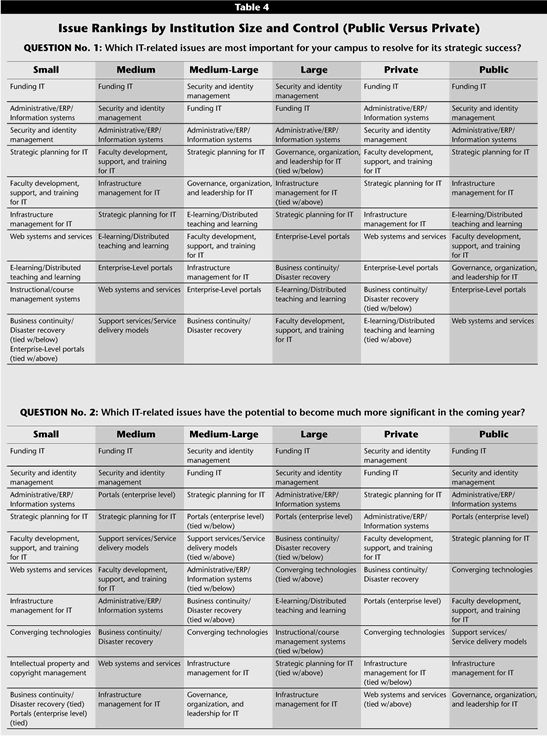
Click image for larger view.
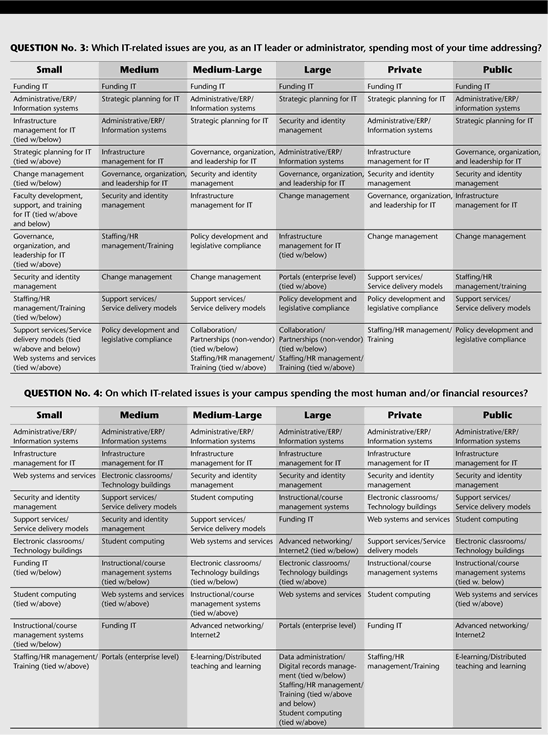
Click image for larger view.
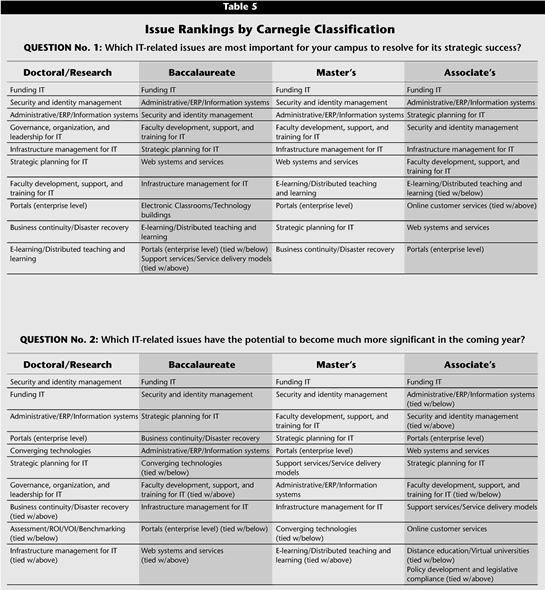
Click image for larger view.
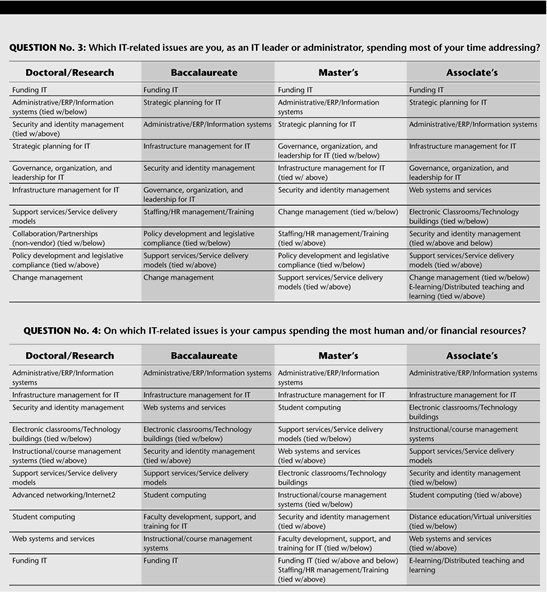
Click image for larger view.
Important to Resolve for Strategic Success
This question continues to show remarkable consistency across institutions of all sizes, control, and Carnegie class, with six out of the top-ten issues considered important for strategic success appearing in all demographics. The top three are the same for nearly all.
- Administrative/ERP/Information Systems
- Funding IT
- Security and Identity Management (ranked fourth for associate’s institutions)
Three other issues appear in the top ten for all groups.
- Faculty Development, Support, and Training for IT
- Infrastructure Management for IT
- Strategic Planning for IT
Issues critical for strategic success that appear for the first time in particular demographics include E-learning/Distributed Teaching and Learning (small, private, and associate’s); Instructional/Course Management Systems (small); Business Continuity/Disaster Recovery (small, medium/large, private, doctoral/research, and master’s); Enterprise-level Portals (small, public, master’s, associate’s); Support Services/Service Delivery Models (medium and baccalaureate); Governance, Organization, and Leadership for IT (public); and Strategic Planning for IT (associate’s).
Perhaps just as significant as new issues appearing in particular response demographics are issues that dropped completely out of the top ten: Staffing/HR Management/Training (small, public, and associate’s); Electronic Classrooms/Technology Buildings (small, master’s, and associate’s); Instructional/Course Management Systems (medium, large, private, public, baccalaureate, and master’s); Web Systems and Services (medium/large); and Advanced Networking/Internet2 (doctoral/research).
Expected to Increase in Significance
Five issues made the top ten list for this question for all sizes, Carnegie classes, and public and private institutions.
- Administrative/ERP/Information Systems
- Enterprise Portals
- Funding IT
- Security and Identity Management
- Strategic Planning for IT
Three other issues made the top-ten list for most of the demographic breakdowns.
- Business Continuity/Disaster Recovery Planning (all but public, master’s, and associate’s)
- Faculty Development, Support, and Training for IT (all but medium/large, large, and doctoral/research)
- Infrastructure Management for IT (all but associate’s)
Issues expected to grow in importance for several demographic groups in 2003 that did not appear at all in 2004 include Assessment/ROI/VOI/Benchmarking; Instructional/Course Management Systems; Staffing/HR Management/Training; and Web Systems and Services.
Converging Technologies,3 a new issue in this year’s survey, was ranked among the top ten in all but medium-sized and associate’s colleges. Strategic Planning for IT was ranked by five groups that did not include it last year: small, medium/large, large, public, doctoral/research, and associate’s. In addition, Strategic Planning rose significantly among the top-ten issues expected to grow in importance for private, baccalaureate, and master’s. We will want to see if these two issues rise further in next year’s survey.
Challenges Demanding IT Administrators’ Time
With notable consistency, the top six of ten issues at nearly all sizes, Carnegie classes, and public and private institutions that are consuming IT leaders’ time are
- Administrative/ERP/Information Systems
- Funding IT (number one for every demographic group)
- Strategic Planning for IT
- Infrastructure Management for IT (except at large institutions)
- Security and Identity Management (except at small and associate’s colleges)
- Governance, Organization, and Leadership for IT (except at small colleges)
New issues demanding IT leaders’ time in particular groups are
- Change Management (at private and master’s institutions)
- Collaboration/Partnerships (non-vender) (at medium/large institutions)
- E-learning/Distributed Teaching and Learning (at associate’s colleges)
- Electronic Classrooms/Technology Buildings (at associate’s colleges)
- Enterprise Portals (at large institutions)
- Governance, Organization, and Leadership for IT (at baccalaureate colleges)
- Policy Development and Legislative Compliance (at all but small and associate’s colleges)
- Support Services/Service Delivery Models (at medium/large and doctoral/research institutions)
- Web Systems and Services (at small and associate’s colleges)
How Institutions Spend Their Resources
Whether IT issues are considered critical for an institution’s strategic success, emerging in significance, or occupying the IT leader’s time, when they make the top ten list of issues on which the campus is spending the most human and/or fiscal resources, they are clearly on the radar screen. Again there are more similarities than differences across institutions of all types and sizes, and from 2003 to 2004. The following issues make the top-ten list for all categories, with the first two ranking first and second for all:
- Administrative/ERP/Information Systems
- Infrastructure Management for IT
- Security and Identity Management (in the top five for all but master’s and associate’s colleges)
- Electronic Classrooms/Technology Buildings
- Instructional/Course Management Systems
- Student Computing
- Web Systems and Services
Support Services/Service Delivery Models was in the top-ten for resource consumption for all categories except large institutions.
While there is a great deal of consistency in top-ten expenditures across all demographic groups, in 2004 there has been much flux within particular groups, reflecting the different choices that IT leaders at different types of institutions must make to allocate resources in financially constrained times. Notable changes in the top ten include the following:
- Advanced Networking/Internet2 (new among medium/large, large, and public institutions)
- Data Administration/Digital Records Management (no longer a top-ten expenditure for small and medium/large institutions)
- E-learning/Distributed Teaching and Learning (new for medium/large, public, and associate’s institutions)
- Faculty Development, Support and Training for IT (no longer a top-ten expenditure for medium-sized and private institutions)
- Security and Identity Management (new for small and associate’s colleges
- Staffing/HR Management/Training (no longer a top-ten expenditure for medium/large, public, doctoral/research, and baccalaureate institutions)
Summary Observation
The economic slide of the past several years—while only just beginning to turn around in 2003—continues to fan the flames of the IT funding crisis, demanding particularly deft leadership for campus information technology and creative management of resources on all sizes and types of campuses. Security and Identity Management, which began rising in importance on larger, public institutions in the 2003 survey, in 2004 is seen as essential for strategic success and as demanding considerable resources among all demographic groups. It remains to be seen whether the reductions in resource allocations reported in this year’s survey will be reversed when IT budgets return to stable growth patterns, and what new trends will emerge as information technology evolves.
Hopefully this analysis of the 2004 Current Issues Survey and related resources on the EDUCAUSE Current Issues Web site (http://www.educause.edu/issues/) will help you better understand the broader context of IT-related issues and help others at your institution understand that these issues are not just challenges for your campus but are prevalent throughout higher education.
Top Ten Current Issues Defined
So what are the top ten issues for 2004? Below, members of the Current Issues Committee have described the top-ten IT-related issues you’ve told us are the most important for your institution to resolve for its strategic success (the top-ten list for Question 1), including some analysis to explain the rankings and year-to-year changes.
No. 1: Funding IT
Accelerating demands for information technology services and rising costs for IT infrastructure renewal and support, coupled with institutional budget cuts at many colleges and universities, have created an ongoing crisis in higher education. Quite simply, total costs for IT are increasing at a rate that exceeds the ability of colleges and universities to pay. The need for realistic strategies to fund IT has never been greater. Answering the following questions, which are based on guidelines offered in a recently published EDUCAUSE executive briefing, should help to evaluate the effectiveness of your institution’s approach to investing in and funding information technology:4
- Are your institutional leaders at the highest levels, as well as key campus stakeholders, engaged in planning for and funding IT as a strategic institutional resource, assessing and aligning the value of IT investment with institutional mission and strategies?
- Are long-term financial plans for IT incorporated into the institution’s overall planning and budgeting processes for effective cost management? Have you determined replacement life cycles for different technologies and incorporated renewal funding into IT budgets? Is the necessary financial investment committed at the time an IT project is approved so that funding will be available over the life of that project?
- In assessing its return on investment, does your institution take into account the qualitative benefits derived from IT in addition to cost savings and productivity gains to evaluate if the IT investment has made a difference? Are expected benefits articulated at the time such investments are proposed?
- Are budget decisions based on accurate and realistic cost figures? Have the costs of delivering IT services been determined, and are efforts made to benchmark those costs against peer institutions? Does your institution track expenditures for IT institution-wide, monitoring distributed expenditures to ensure that all IT resources are leveraged, planned for, and budgeted coherently?
- Does your CIO work with your CFO to develop budgets that recognize the need for both operating and capital support, to ensure coverage of maintenance and renewal and ongoing staffing and support costs, as well as investment in new systems and infrastructure?
- Have you standardized hardware, software, and support services as much as possible to enable economies of scope and scale in delivering baseline services?
No. 2: Administrative/ERP/Information Systems
Of the 645 institutions that completed the EDUCAUSE core data survey last year, only 23 percent had no plans to implement an enterprise resource planning (ERP) system, with 37 percent having already completed such an implementation, 26 percent in process, and 13 percent considering it. Projects of this scope demand large investment and commitment by institutional and IT leadership, both before and after implementation. Some questions that need to be addressed when considering or implementing enterprise systems include the following:
- What are the mission-critical factors driving your institution’s decisions to implement enterprise system solutions? What service and process improvements are expected with successful implementation? Are there viable alternatives, such as enhancing existing legacy systems?
- If a decision has been made to implement new systems, should you partner to build, buy off the shelf, or integrate? If you are purchasing a commercial product, will the functionality of the system expand to accommodate integrating and interfacing with courseware systems, portals, and so forth?
- Is institutional leadership committed to the system implementation? Will the implementation include participation by stakeholders from both technical and functional areas? How will their expectations be managed, and have they resolved data ownership issues?
- Does the new system fit the institution’s technical strategy at the back-end and network levels? Does the system comport with preferred data-handling strategies, such as authentication, security, and privacy?
- Will the campus adapt its business processes to the best practices configured in the enterprise solution, to minimize or avoid customization? Have current processes and desired process improvements been identified, documented, communicated, and understood? Are the new functional and system requirements realistic? Will institutional leadership support needed business process changes?
- Have you analyzed personnel needs, both in terms of staffing levels and available technical expertise, for adequate support before, during, and after implementation? Does your implementation partner have sufficient higher education experience, seasoned staff, and a proven track record?
- Does your support plan identify the roles and responsibilities of technical, functional, and user groups and include adequate training for system users both during implementation and on an ongoing basis?
- If you have completed your implementation, does your institution get more timely and intuitive access to information, especially for strategic planning and decision-making? Have reengineered processes improved operations and increased efficiency? Has the system improved services for students, faculty, staff and administrators?
No. 3: Security and Identity Management
Comprehensive network access increases opportunities and risks associated with information storage, transmission, and access. This access, together with regulatory requirements, distributed architectures, and hostile elements on the Internet, presents challenges for funding and implementing security practices and required policies. Issues an institution needs to consider include:
- How will your institution balance the need for security with the tradition of open networking? Will a more secure environment be viewed as intrusive or controlling?
- Managing a distributed environment requires both a comprehensive technical plan and a complementary policy architecture. Is your campus planning and maintaining these?
- Are your institution’s policies up to date and enforceable? Do they reflect institutional priorities and strategies, legal regulations, and "best practices"?
- Do you have strategies to manage security as new technologies become available? Are your institution’s security plans and policies reviewed and updated to reflect new technologies?
- Given the increasing importance and the complexity of security, does your campus have the trained staff to undertake this job? Is there a Chief Information Security Officer or the equivalent to provide leadership for and focus on security? Do other campus units recognize this role?
- Has the number of security incidents and remedial costs during the past year led to increased funding for staffing and tools? Have these incidents highlighted the risks of underinvesting in security?
- Are institutional users aware of and implementing security measures (patches, firewalls, anti-virus) to protect their systems and data? Does your infrastructure facilitate measures to improve security? Is your institution providing funding to facilitate and support such measures on a campus-wide basis?
- Many campuses are developing methodologies for authentication, authorization, and secure transmission of confidential information. Such technologies require policy and technological decisions. Are you engaging all stakeholders in your planning and decision making?
- Is your institution properly responding to regulatory issues—FERPA, HIPAA, GLB, USA PATRIOT, DMCA, and others? Has your institution taken sufficient measures for compliance with these acts?
- Has your institution recognized and reduced the risk of identity theft by limiting the use of Social Security numbers?
- Identity management problems frequently are facilitated by inadequate communication of personnel changes. Has your institution reviewed/changed its practices to minimize this risk?
No. 4: Strategic Planning for IT
Strategic planning for IT must be based on three fundamental tenets: 1) IT is a strategic institutional asset; 2) IT is an essential resource for learning, teaching, research, and community partnerships; and 3) IT is vital to the effective operation of the institution.
The IT strategic plan must be presented and accepted as the institution’s plan, not the IT division’s plan, and it must have executive commitment and leadership. Development of the IT strategic plan must be an ongoing process, which involves all constituent groups in the planning and prioritizing processes.
It is extremely difficult to look into the future, especially in this rapidly changing Information Age; it is imperative, however, to do so in order to avoid technologies that may lead to a dead-end or significant lock-in and high switching cost.
Key issues that must be addressed include:
- Does the IT strategic planning and budgeting process align with the institution’s strategic-planning and budgeting process? How are conflicting priorities resolved?
- Does the IT strategic planning process align with the academic strategic plans and the stated vision and mission of the institution? Is adequate time allowed to prepare for emerging technologies?
- Does the IT strategic plan align with the defined goals and objectives and the key performance indicators (metrics) of the institution? Is there a defined process for assessing, maintaining, and modifying the plan as needed?
- Are the goals and objectives of the IT strategic plan realistic? Are there significant obstacles to achieving the goals and objectives of the plan? How can these obstacles be overcome? Are critical or new skills required to meet the goals and objectives?
- Are all stakeholders involved in the planning process? Have IT steering committees or advisory committees been established to contribute to the planning process?
- Does the IT strategic plan provide a framework for efficient and effective services to the students, faculty, and staff?
- Has an assessment been performed to delineate the current IT environment? Have new IT functions and services been identified that are necessary to support the institution’s vision, mission, goals, and objectives?
No. 5: Faculty Development, Support, and Training
Colleges and universities commonly provide faculty with easily accessible resources for their continuous learning through faculty development programs. With the rapid development of new technologies, the constant enhancements and upgrades to existing technologies, these programs increasingly incorporate faculty technology training and support models. Some of the issues related to faculty development, support, and training for information technology are:
- What faculty development model will ensure that all faculty members benefit and are successful? Is a systemic approach (that is, a model supported by institutional leadership that provides technical support staff for all faculty, not just leading-edge innovators) enough to ensure faculty success? What is the role of technology-proficient faculty in supporting and training their peers? Does a model that employs such faculty as mentors accelerate faculty success in incorporating technology, thereby improving learning?
- With the rapid development of new technologies, constant enhancements, and upgrades to existing technology, how can faculty find time to stay current? What are the benefits of providing e-learning options when delivering IT faculty training and support?
- What is the role of local, regional, and national conferences in IT faculty development? Can we measure the benefits the institution realizes in supporting faculty attendance at such technology conferences?
- How should colleges and universities reward faculty who are using technology to improve learning? How do institutions encourage faculty to stay current?
- How can we measure the success of a faculty development program? Is it based on the number of attendees, improved student satisfaction, improved student learning, and/or the percentage of faculty who continue to participate in ongoing technology training?
- Is it important to have a dedicated physical space for IT faculty development to ensure success? How do institutions encourage the use of teaching excellence centers after the newness wears off?
- Who is best equipped to train faculty in the use of new and existing technologies? How can we integrate technology training and pedagogy so that faculty will respect the program?
- Is there a role for an advanced technology champion—someone who experiments with new technologies and tries to understand the educational fit and then champions their use?
No. 6: Infrastructure Management for IT
In an EDUCAUSE Review article two years ago, Richard Katz posited that the technology foundation that supports a campus’s business and academic processes, which he called the Information and Communications Technology (ICT) infrastructure, is rapidly expanding beyond our traditional understanding of the network and related wiring structures and "black box" devices.5 While most users still take IT infrastructure for granted, the systematic upgrade and improvement of the ICT infrastructure is pivotal to meeting the campus’s ever-expanding use of academic and administrative technology applications. Without quality-of-service functionality, multi-layer networking, Fast- and Gig-Ethernet, and proper infrastructure deployment, emerging technologies such as voice-over-IP (VoIP) and video-over-IP cannot be implemented. In addition to keeping the ICT infrastructure up-to-date, effective monitoring and management of the network pays dividends in reducing overall operating costs and avoiding disruptive down time
Some things to consider in maintaining and upgrading your network and related ICT infrastructure include:
- Do you proactively plan for and implement a policy to replace computers and routinely upgrade network devices, as well as periodically evaluate and renegotiate software license agreements? Does your plan include benchmarks for network utilization to assist in planning for future upgrades?
- Does your plan include providing the proper resources and assets to adequately support your infrastructure, including 24 x 7 network support? Do you have redundancy built into your network design to limit network outages? Is training a priority for those who support your infrastructure?
- As institutions increasingly depend on the Web to conduct everyday business, have you included redundant Internet gigapop access routes/points in your plan? Does infrastructure planning include accommodations to systematically upgrade key server farms that support the growing campus instructional support and ubiquitous Web environments?
- What information do you use to size your network technology infrastructure? Who determines the applications that will be running on the infrastructure and how much excess capacity is enough? Do you have the ability to shape your bandwidth for priority services, and are you able to effectively manage recreational traffic on your network?
- Is your network and IT infrastructure ready for emerging technologies such as the convergence of voice and data, video-over-IP, wireless technologies, and mobile computing? How do you carve out time and money to pilot network and other infrastructure advances, while continuing to maintain and support the current investment?
No. 7: E-learning/Distributed Teaching and Learning
E-learning, often described as distributed learning, has been steadily growing as both an alternative to and an enhancement of traditional campus based learning. E-learning and distributed teaching and learning speak to learner needs for flexibility and mobility, while offering institutions a way of addressing issues of access and capacity. While e-learning presents new opportunities, it also presents some challenges and unique issues, including the following:
- How do we develop within institutions and partnerships a clearly articulated, well understood vision and strategy to build a sustainable e-learning model? How aggressively should we promote e-learning environments on campus? What changes are required in services and spaces on campus to enable e-learning?
- How do we support faculty in the move to a more learner centered e-learning environment? How can we work most effectively with faculty, instructional designers, librarians, programmers, and media specialists in developing new digital resources, including institutional information repositories and learning object repositories? How can we support the development of standards for the description of and access to digital resources?
- How can we ensure that students have the personal-learning, time-management, and technology skills necessary to succeed in an e-learning experience? Will we be able to provide all students access to support and services in an e-learning environment? How do we support students and faculty in the development of e-portfolios?
- What is the best technical infrastructure to support e-learning? Must we develop broadband networks to support multimedia in e-learning? How do we select and appropriately support course management systems? What are the opportunities and barriers associated with open source development and open architecture for such systems? How do we ensure interoperability?
- How can we ensure quality in the e-learning experience, especially to assess learning and course outcomes? Can we build an assessment model for e-learning that takes into account educational theory and recognizes best practices? Can such a model be appropriate for a variety of e-learning experiences, including on and off campus, fully online, and/or hybrid learning experiences that integrate some online elements into traditional face-to-face instruction?
- What potential do new technologies such as videoconferencing, videostreaming, virtual reality, and online gaming environments have to enrich e-learning?
No. 8 (tie): Web Services/Web-Based Systems
Web services is a relatively new term used to describe new software standards that allow for integration of different applications as well as the secure exchange of data over the Internet. The term can be misleading, as it is often thought to refer to the myriad of services that are offered through a Web interface. In fact, Web services refers to a set of standards that enable "conversations" to occur between applications as easily as they occur between Web browsers and servers. These services are available over the Internet or private (intranet) networks, they use a standardized XML messaging system, and they are not tied to any one operating system or programming language. When mature, Web services will shift the focus of the Web from "human-centric" to "application-centric."
The Web has brought other new considerations into play as well. With much of the institution’s information in electronic form and continually changing, the issue of content management becomes much more critical. Also, the transition from host-based legacy systems to Web-accessible systems is still under way at most institutions. How to manage and provide coherent access to such a heterogeneous environment adds complexity to the enterprise IT architecture.
Following are several key considerations:
- Web services are still in the development and refinement stage, particularly as they relate to security standards. Many technical issues still need to be resolved; however, institutions would be wise to anticipate the use of Web services technology as they develop strategic plans.
- Future plans should include consideration of middleware technologies such as portals, central directory services, and security systems. The centerpiece of the last will be strong institutional authentication and identity management systems that control access, support single sign-on, manage trust relationships, and protect privacy.
- The content management tools marketplace is immature, but institutions would be wise to watch it closely.
- The contemporary strategy to providing coherent online access to services is with a portal. However, the marketplace offers multiple alternatives, such as ERP portals and course management system portals. The challenge will be how to integrate these.
- For now, we should approach new purchases expecting vendors to be increasingly sensitive and responsive to our desire for standard integration and to begin to support this incrementally while working toward full integration.
No. 8 (tie): Enterprise-Level Portals
Portals are now a prominent part of the Web architecture on which campus information sits and where integration of data, information, and applications takes place. Saha’s definition of a portal as "a single integrated point of comprehensive, ubiquitous, and useful access to information (data) applications, and people" comes from the e-business perspective.6 The scholar’s portal perspective, described by Campbell, emphasizes facilitating access to and growth of scholarly digital information resources of all kinds including searching across databases and offering a variety of supporting tools resulting in a powerful distributed digital library.7 Brogan’s survey of digital aggregation services highlights the extensive efforts under way to create cross-searching capability to handle not only an institution’s resources but also cross institutional resources and services.8 Also related to portal building is the emerging concept of the institutional repository, which Lynch describes as "a set of services that a university offers to the members of its community for the management and dissemination of digital materials created by the institution and its community members."9
A robust architecture to manage multiple business functions, effective aggregation search processes for accessing and managing information resources, and a way to add and archive campus resources are prominent goals at many colleges and universities. Thus, we seek to include the following capabilities in portals:
- serve as a managed signature entry point for targeted internal and external audiences
- accommodate institutional branding and marketing by standardizing the portal appearance everywhere
- offer a high level of customization so users can alter the look and feel of their personal entry point
- handle different levels of security for sensitive, confidential, or licensed information assets
- feature robust search engines able to perform sophisticated broadcast searching over a variety of databases and data sources sitting on different platforms
- offer sophisticated personal information management tools so users can effectively organize and keep track of administrative and scholarly digital information, including easy-to-use intake systems for adding resources
Challenges in meeting these goals include:
- meeting the needs of the diverse campus communities, as well as external groups such as alumni and prospective students
- combining sophisticated functionality over a variety of platforms
- managing the tension between standardization, branding, and creative approaches
- keeping enterprise-wide portals and sub portals current and accurate
- training users to use the portal and its contents effectively
No. 10 (tie): Business Continuity/Disaster Recovery
Information technology has become critical to the daily operation of colleges and universities. Indeed, current practices in administering, teaching, and communicating within academic environments would be vastly altered without the information systems that many take for granted. Thus the successful implementation and maintenance of business continuity and disaster recovery (BC/DR) planning and practice rise in importance. The threat of the Y2K bug and the tragic events of September 11, 2001, initially focused attention on these practices and caused many institutions to formulate plans. However, blackouts affecting the Northeastern United States, Canada, and parts of Europe during the latter half of 2003, and the continued penetration of technology into our daily lives, have made us realize that BC/DR planning is a process requiring ongoing attention. Institutions need to reassess their BC/DR planning and processes. Continued success will require creative leadership and broad participation. Some questions that might arise during the planning and ongoing maintenance process include the following:
- What business processes depend on IT systems? Are critical business processes defined and clearly understood? Are individuals prepared to respond to a disruption? What information and training must be provided to individuals who might be directly involved?
- What IT systems are important at each level of the institution (individual, department, organization, institution)? What systems are essential? What is the impact of a system loss? How long can the institution sustain an outage?
- Has the institution defined a process for declaring an incident, its degree, and required response? Who will lead the incident response and who will participate? How will the response team communicate among themselves? How will the institution communicate with external entities, including customers and the press?
- How does the institution assess risk? What level of risk is tolerable? Does this level vary by department or business practice? What are the one-time and recurring expenses that the institution can, will, or must allocate to mitigate risks?
- How does the institution maintain currency of its BC/DR strategy and plan? Should the institution build continuity management costs into new system and service development?
Business process reengineering efforts or planning for the unexpected will take staff time, funding, knowledge, and support from the highest administrative levels. Business continuity and disaster recovery is disaster preparedness.
No. 10 (tie): Governance, Organization, and Leadership for IT
With funding for information technology continuing to be the major challenge (ranked #1 again this year), and with increasing pressures to deliver effective solutions and services at the lowest cost, there appears to be a growing awareness among CIOs of the importance of governance and organizational issues to their institution’s strategic success. Congruently, CIOs appear to be spending more time on challenges associated with these issues. Institutional decision-making bodies as well as state legislatures and governing boards are questioning existing governance models and organizational structures. The qualities and abilities of IT leaders are contributing factors to IT governance and organizational effectiveness and efficiency. Some of the questions that might be asked about an institution’s IT governance, organization, and leadership for IT include:
- What is the current IT governance model (centralized, decentralized, distributed, hybrid) and is it effective? Does the institution have effective policy bodies and advisory groups for IT, for example, an IT steering committee, technology council, faculty technology committee, and so forth?
- Has an effective and efficient IT organizational environment been established, with effective IT teams, collaboration across organizational boundaries, and cooperative working groups?
- Is there synergy between IT organizations and support groups, and are they communicating effectively? Are there clear lines of responsibility and defined roles for IT professionals throughout the institution?
- Is the IT organization nimble, flexible, innovative, productive, responsive, and customer-service oriented? Does the CIO listen to campus needs and promote excellent customer service?
- Does the CIO have access to the president or chancellor of the institution, especially as a member of the executive cabinet, and is the CIO able to influence decisions that are important to IT planning and strategies?
- Does the CIO develop and effectively manage relationships with internal and external constituencies? Is the value and importance of IT being communicated by the CIO? Is the CIO effectively planning, implementing, and delivering desired outcomes and results? Is the CIO an advocate for IT, the IT organization, and the institution?
- Does the CIO help define priorities, make timely decisions, and work on securing resources? Does the CIO have a thorough understanding of higher education and institutional issues and align IT resources to address strategic and operational needs?
- Is the CIO a change agent, proactively contributing to the discussions regarding new governance models and organizational structures?
